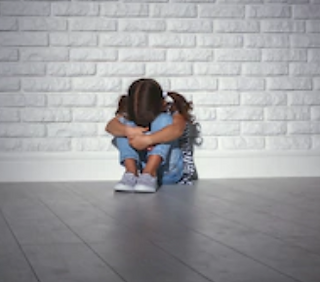FEAR & PHOBIA

Young children have more fears and phobias than adults do,
and they experience the emotion of them more intensely. Novelty, unpredictability and sudden changes can also induce fear in children, and illness might 'push them back', reviving old fears that they had put behind them at an earlier age.
Adults also teach children to fear certain things before the child has even come across them, through their words or actions. Children may also 'pick up' the fears of adults in their family.
The objects and situations that children fear vary a good deal. When very young children show fear, it can be hard to judge what exactly is causing it, and many parents underestimate the number of things that frighten their children.
The following is a general list of normal fears:
Ages 2 - 4:
Fear of animals, loud noises, being left alone, inconsistent discipline, toilet training, bath, bedtime, monsters and ghosts, bed wetting, disabled people, death and injury.
Ages 4 - 6:
Fear of darkness and imaginary creatures, as well as animals, bedtime, monsters and ghosts. Other fears, such as fear of strangers, seem to be persistent. 'Stranger fear' would probably be considered as 'shyness', while fear of snakes tends not to decrease much, if at all, during this period. Children at this age may also fear loss of a parent, death, injury and divorce.
Beyond these ages, irrational fears tend to decline rapidly, though there may be further peaks to do with other situations, for example:
Ages 9 - 11:
Fear of school, fear of blood and injury.
Older children tend to worry more about death and related topics such as nuclear war. Up to age 11, boys and girls tend to be equally represented in the 'fear tables'; after the age of 11, boys lose their fears more rapidly than girls.
8 year olds will probably have fragments of earlier fears but additional ones will tend to be more rationally based and will possibly include fear being late for school, social rejection, criticism, new situations, adoption, burglars, personal danger and war.
9 and 10 year olds are also likely to fear divorce, personal danger and war and these three are very likely to continue as fear problems into the mid teens. This age group might also fear blood and injury.
11 and 12 year olds might fear animals, kidnapping, being alone in the dark and injections. Research showed that beyond this age boys lose their fears more readily than girls.
13 year olds seem to fear heights as well as the three mentioned above.
14 - 16 year olds tend to have a wide range of rational or almost rational fears which might include: injury, kidnapping, being alone in the dark, injections, heights, terrorism, plane or car crashes, sexual relations, drug use, public speaking, school performance, crowds, gossip and divorce.
As will be noted from the above, many childhood problems wax and wane as a normal part of development and a sensitivity in a certain area might be aggravated by a current problem so that this particular child temporarily ‘falls back’ into an earlier level of fear when faced with a trauma or severe family or school problems.
Symptoms of Phobia
Phobias produce all the unpleasant physical symptoms of 'normal' fear:
-
Heart palpitations
-
Feeling sick
-
Chest pains
-
Difficulty breathing
-
Dizziness
-
'jelly legs'
-
Feeling 'unreal'
-
Intense sweating
-
Feeling faint
-
Dry throat
-
Restricted or 'fuzzy' vision or hearing
In severe cases, children may feel certain that they are about to die, go mad, or lose control of themselves and injure someone, or do something disgusting and humiliating. Most of all they feel an overpowering urge to 'escape' from the situation they are in. Children are more likely to cry, shout or scream, or simply run away when confronted by the things they fear, though they may also be sick or go rigid. Paleness, perspiration and trembling are also signs of severe anxiety.
The level of symptoms that children with phobias experience varies a great deal, from very mild anxiety to very severe panic and terror. A mild degree of nervousness in particular situations is not usually a problem, but it is only a matter of degree, and at the other end of the scale there are children who have full-scale panic attacks when in the dreaded situation, and soon refuse to enter it altogether because of the terror that grips them at such times.
Phobias aren't just severe anxiety: the anxiety is turned into a phobia by avoidance. In the early stages of a phobia the child's parents sometimes try to tackle his or her fears head on by forcing him or her to enter the feared situation. If this works, the phobia can be overcome. If it doesn't, this is only likely to strengthen the fears and make the child want to avoid the phobic situation even more. It also risks destroying the child's confidence in it's parents.
Avoidance is attractive because it brings a reduction of the tension; thus it rapidly becomes a habit.
How Can Childrens' Fears Be Treated?
Persistent fears in children and interfering with the day-to-day functioning would require professional help to consider a treatment program. Children in particular seem to respond best to being helped to increase their skill and competence, and being encouraged to take part in activities that will involve the thing they fear. With young children especially, practical activities that involve exposure could also be turned into a game, since most children respond better to play than to work.
The objects and situations that children fear vary a good deal. When very young children show fear it can be hard to judge exactly what is causing it, and many parents underestimate the number of things that frighten their children.
Cambridge Medical Centre (CMC) Child & Adolescent Mental Health information publications Copyright 2018.

